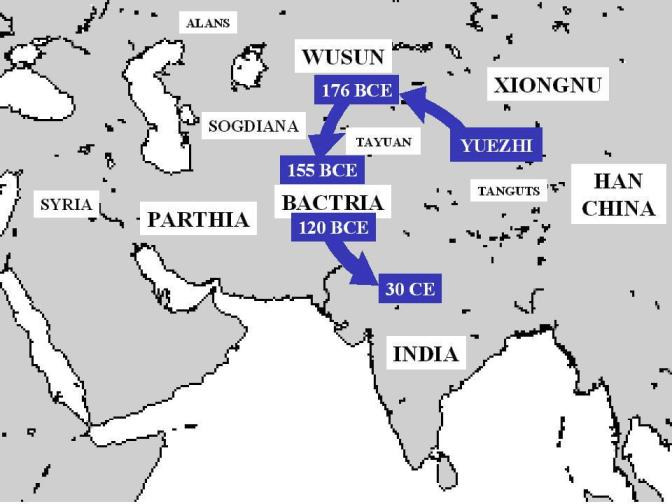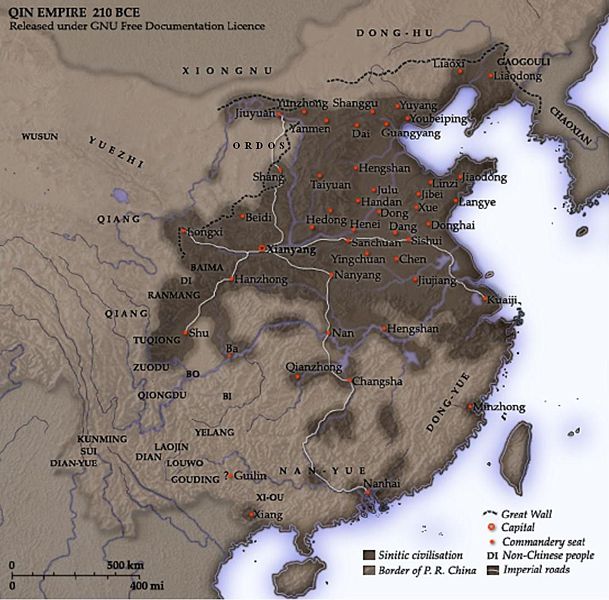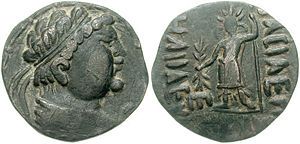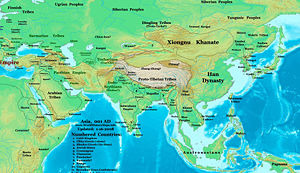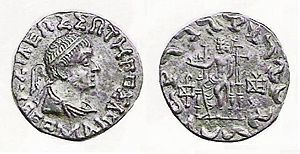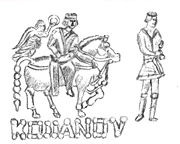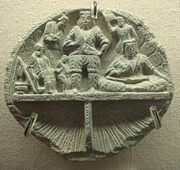- 글쓴이: 이태수 조회수 : 183 08.08.15 01:25 http://cafe.daum.net/chosunsa/1Wte/25

|
월지족은 의견이 너무 많고 일치점을 찾기 어렵습니다. 이 페이지를 번역하다가 참고문헌에서 북경사범대 서문명의 논문을 먼저 번역해서 이 사이트에 올렸습니다. 같이 참고하시기 바랍니다. 거짓 속에서 진실 찾기 게임 같습니다. 서문명 논문 “카니시카왕과 대월지 왕계”의 연대와 이 페이지에서 연대는 차이가 많이 납니다. 총분량 23페이지. 번역 정성이 그 전만 못한 것 같습니다. 양해 바랍니다. 또 영어 원문에 구문 에러가 있는 문장이 많습니다. 월지족 Yuezhi From Wikipedia, the free encyclopedia
Yuezhi/Rouzhi (Chinese: 月氏, also 月支, Wade-Giles: Yüeh-Chih) or Da Yuezhi/Da Rouzhi (Chinese:大月氏, also 大月支, "Great Yuezhi") "The Great Clan of Yue/Rou", is the Chinese name for an ancient Central Asian people. (This 月 is not moon. It's originally 肉(rou) as a character component.)(See Chinese Wikipedia to get the source) There are numerous theories about the derivation of the name Yuezhi and none has yet found general acceptance.[5][6] In Chinese the name translates literally as 'Moon Clan.' According to Zhang Guang-da the name Yuezhi is a transliteration of their own name for themselves, the Visha (the tribes), being called the Vijaya in Tibetan.[7]. They are believed by most scholars to have been an Indo-European people,[8] and may have been the same as or closely related to the Tocharians (Τοχάριοι) of Classical sources.[9] They were originally settled in the arid grasslands of the eastern Tarim Basin area, in what is today Xinjiang and western Gansu, in China, before they migrated to Transoxiana, Bactria and then northern South Asia, where they formed the Kushan Empire. 월지(月支)/육지(肉支)/월씨(月氏), 또는 대월지(大月支): 월-대부족(대월지)은 고대 중앙아인에 대한 중국식 명칭이다. (月은 달을 의미하는 것이 아니라 원래는 육(肉)이다) 월지에 대한 파생어에 대하여 수많은 이론이 있으며, 아직까지 아무도 공론(公論)을 찾지 못하고 있다. 중국어에서 이 명칭은 ‘달 부족’으로 번역할 수 있다. 장광다에 의하면 명칭 월지는 고유명에 대한 음역으로, 마치 비샤족은 티벳어로 ‘비자야’로 불리는 것과 같다. 대부분의 학자들은 월지족은 인도-유럽인이었을 것으로 보고 있으며, 상고사에서의 토하르족과 같거나 밀접하게 관련된 것일 수도 있다. 월지족은 원래 중국 감숙성 서부와 [남아시아: 여기서는 주로 인도 지역을 가리킨다. 남아시아 북부는 파키스탄과 아프가니스탄에 해당된다. ] {해설: 월(月)을 부수로 사용할 때 육달월이라 한다. 즉 月은 肉의 약자이다. 고대어에서 月과 肉의 발음이 같았을 것이다. 월지는 Odi의 음역이라는 것이 있는데, 출처는 알 수 없다. 북경대 서문명은 Odi라고 했으나 출처를 밝히지 않았다. 그렇다면 월(月)은 ‘올’, 지(支)는 ‘디’일 수 있으며, 올디=Ordi로 볼 수 있고, Ordi는 ‘천막’이라는 뜻이 되고, 월지족은 천막생활을 하는 유랑 유목민이라고 할 수 있다. } 1) 기원 The first known reference to the Yuezhi was made in 645 BCE by the Chinese Guan Zhong in his Guanzi 管子(Guanzi Essays: 73: 78: 80: 81). The dates of this book are disputed however, and it may date to as late as 1st century BCE.[10] The book described the Yuzhi 禺氏, or Niuzhi 牛氏, as a people from the north-west who supplied jade to the Chinese from the nearby mountains of Yuzhi 禺氏 at Gansu.[11] The supply of jade from the 월지에 대한 처음으로 알려진 언급은 기원전 645년 관중(管仲)의 관자(管子)라는 책에 있다. 이 책의 연대는 논란의 여지가 있지만 늦어도 기원전 1시기이다. 이 책에서 우씨(禺氏) 또는 우씨(牛氏)를 서술했고, 이들은 감숙성 근처의 우씨 산에서 중국인에게 비취를 제공했던 북서부 사람이라고 했다. 고대부터 타림분지에서 비취를 제공하였다는 것은 정말로 고고학적으로 증거자료가 잘 제공된다. 잘 알려진 것으로 고대 중국 통치자들은 비취에 강한 집착이 있었다. 상(商)왕조의 부호(婦好) 무덤에서 발굴된 모든 비취 품목은 750점이 넘고, [저(氐),씨(氏)의 고음은 “디”라고 볼 수 있다.] 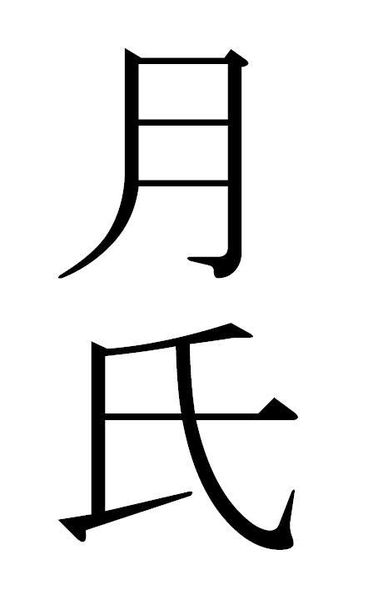 Rouzhi/Yuezhi (lit. "Rou(maybe Meat, but not Moon) People")[citation needed] was the name used continuously by ancient Chinese historians to designate the tribe throughout its migrations, from the time it was in the eastern Tarim Basin area (7th to 2nd century BCE[citation needed]) to the time it ruled the Kushan Empire in India (1st-3th century CE). 육지족/월지족(육(肉)을 뜻하고, 달을 뜻하는 것이 아님/논거가 필요함)은 고대 중국인 사가들에 의해 끊임없이 사용된 이름으로 유목민을 가리키고, 기원전 7세기부터 기원전2세기까지 타림분지 동부에서 있었던 때부터, 서기 1세기부터 3세기까지 인도의 쿠샨왕조를 통치했던 때까지 월지족이라는 이름이 사용된 것이다. According to former 구 소련 학자 주에프(Zuev)에 의하면, 대월지족에 여왕이 있었고 기원전3세기경에 황하의 상류에 있는 토하르(대하)를 합병하였다. 그에 의하면 중국 년대기는 여왕의 부족을 대월지라고 부르고, 대하/토하르를 소월지라고 부르기 시작했다. 동시에 이 둘을 단순히 월지라고 불렀다. 서기 5세기에, 학자 겸 승려인 구마라습은 중국어로 번역하면서, “토하르”를 “월지”라고 번역했다. 기원전 2세기 중반에 월지는 박트리아를 정복했고, 고대 희랍 작가가 말하기를 박트리아를 정복한 자들은 아시족과 토하르족이라고 했다. 박트리아는 그 때 중국 연대기에 의하면 대하국으로 불리기 시작했는데, 예를 들면 토하리스탄과 박트리아/토하리스탄의 언어는 “토하리안”이라고 불리기 시작했다. [토하리스탄은 토하르국을 가리키고, 토하리안은 토하르 언어 또는 토하르 부족을 가리키는 듯하다. 희랍어 표현임.] {정말 혼란스러운데, 황하강 상류에 어떻게 대하가 있을 수 있는가? 혹시 황하는 아무다르여강을 가리키는 것은 아닐까? 왜냐면 대하는 “아무다르여강” 상류로 공인되고 있기 때문이다.} The Yuezhi are also documented in detail in Chinese historical accounts, in particular the 2nd-1st century BCE "Records of the Great Historian", or Shiji, by Sima Qian. According to these accounts: "The Yuezhi originally lived in the area between the Qilian or Heavenly Mountains (Tian Shan) and Dunhuang, but after they were defeated by the Xiongnu they moved far away to the west, beyond Dayuan, where they attacked and conquered the people of Daxia and set up the court of their king on the northern bank of the Gui [= Oxus] River. A small number of their people who were unable to make the journey west sought refuge among the Qiang barbarians in the Southern Mountains, where they are known as the Lesser Yuezhi.",[13] 월지는 또한 자세하게 중국 사료에 기록되어 있는데, 특히 기원전2세기-1세기에, 사마천의 사기에서다. 이 사료에 의하면: “월지는 본디 기련 또는 천산과 돈황 사이의 지역에 살았고, 그러나 흉노에게 패한 후에 서쪽으로 멀리 대완(大宛)을 넘어 이주하였으며, 그곳에서 대하를 공격하여 정복했으며, 규수(아무다르여강)의 북안(北岸)에 왕궁을 세웠다. 서쪽으로 떠날 수 없는 소수 부족은 남산의 저강족(氐羌族) 속에서 정착하였으며, 이들을 “소월지”라고 부른다.” [여기서 남산은 우전의 남쪽에 있는 곤륜산이 될 수도 있고, 감숙성의 기련산이 될 수도 있다. ] The Qilian and Dunhuang original homeland of the Yuezhi have recently been argued not to refer to the current locations in Gansu, but to the Tian Shan range and the Turfan region, 1,000 km to the west, Dunhuang identified with a mountain named Dunhong listed in the Shanhaijing.[14] 월지의 본고향 기련과 돈황은 최근에 감숙성의 현위치를 가리키는 것이 아니라 서쪽으로 1천Km 떨어진 천산산맥과 투르판 지역이라는 주장이 제기되었으며, 돈황은 산해경에 있는 돈훙(敦薨)산{천산(天山)}과 같은 것이라고 한다. The Yuezhi may have been a Caucasoid people, as indicated by the portraits of their kings on the coins they struck following their exodus to Transoxiana (2nd-1st century BCE), and especially the coins they struck in 월지는 백인(코카서스인)일 수도 있는데, 왜냐하면 기원전 2세기-1세기에 트란스옥시아나로 이주한 후에 주조한 주화에 있는 왕들의 초상화가 제시하고 있으며, 특히 서기 1세기-3세기의 인도 쿠샨왕조에서 주조한 주화가 증거를 제시하고 있기 때문이다. Ancient Chinese sources do describe the existence of "white people with long hair" (The Bai people of the Shan Hai Jing) beyond their northwestern border, and the very well preserved Tarim mummies with Caucasian features found at the ancient oasis on the Silk Road, Niya, often with reddish or blond hair, today displayed at the Ürümqi Museum and dated to the 3rd century BCE, have been found in precisely the same area of the Tarim Basin.[16] 고대 중국 사료에서 북서부 경계를 넘어 “긴 머리의 백인”(산해경의 백인)의 존재에 대하여 분명히 서술하고 있다. 잘 보존된 타림 미라는 코카서스인(백인) 얼굴을 하고 있고, 실크로드 고대 오아시스 “니야”에서 발견되었으며, 붉은 머리 또는 금발을 하고 있으며, 현재는 우루무치 박물관에 전시되고 있으며, 년대는 기원전 3세기에 해당되는데, 정확히 타림 분지의 같은 장소에서 발견되었다. [우루무치: 우루음치 또는 적화(迪化)라고 함. 우루무치는 몽골어로 ‘아름다운 목장’이라는 뜻. 적화는 만주어로 “깨달음”이라는 뜻.] The Indo-European Tocharian languages also have been attested in the same geographical area, and although the first known epigraphic evidence dates to the 6th century CE, the degree of differentiation between Tocharian A and Tocharian B, and the absence of Tocharian language remains beyond that area, tends to indicate that a common Tocharian language existed in the same area of Yuezhi settlement during the second half of the 1st millennium BCE. 인도-유럽 토하르 언어들은 또한 지리적으로 같은 지역임이 입증되었으며, 비록 첫번째로 알려진 명문(銘文) 증거는 서기6세기를 기록하고 있고, 토하르어 A와 토하르어 B의 차이정도와 토하르어가 없는 곳이 그 지역을 넘어서 존재하지만, 토하르 공통어는 기원전 500년부터 기원후까지(500년간) 월지족 정착지와 동일한 지역에 존재했음을 가리키는 경향이 있다. [불완전 문장입니다. 뜻은 월지족 정착지에 토하르 언어가 존재했다는 것.] According to one theory, the Yuezhi were probably part of the large migration of Indo-European speaking peoples who were settled in eastern Central Asia (possibly as far as Gansu) at that time. The nomadic Ordos culture, who lived in northern According to Han accounts, the Yuezhi "were flourishing" during the time of the first great Chinese Qin emperor, but were regularly in conflict with the neighbouring tribe of the Xiongnu to the northeast. 어느 설에 따르면, 월지족은 아마도 인도-유럽어를 말하는 종족들의 대 이동 중의 일부였을 것이고, 그들은 그 당시에 중앙아시아 동부에 정착했다(어쩌면 감숙성에도). 오르도스 문화를 갖는 유목민은 월지의 동쪽 즉 중국 북부에 살았으며, 또 다른 사례이다. 또한 파지릭의 코카서스인 미라는, 아마도 스키타이 출신일 것이고, 월지족으로부터 북서쪽으로 약1500Km 떨어진 곳에 위치하고, 기원전3세기경이다. 한나라 사료에 의하면, 월지족은 진시황 때에 번영했으며, 그러나 북동쪽의 흉노와 자주 충돌하였다. ----- 여기서부터 제2장까지는 이 사이트에 먼저 올렸던 내용입니다. ------ [파지릭: 알타이 산맥, 시베리아, 노보시비르스크에 사는 유목민으로, 중국, 몽고, 카자흐스탄의 국경선 지역이다. 스키타이를 닮았다.] [오르도스(악이다사): 내몽고 자치구의 오르도스 사막을 가리킴. 흉노에 의해 쫓겨 기원전6세기-2세기에 기마유목민이 정착했다. 레베딘스키에 의하면, 스키타이족이고, 동(東) 월지족이라고 한다. 특히 사카족과도 관련이 있다. 문화적으로 동호(東胡)와 관련이 있다. 또한 저강족(氐羌族)과 관련이 있다. 어느 사료에 의하면, 오르도스 지역은 돌궐족의 전설적인 고향이라고 한다. – 이상 영문 위키에서 발췌.] {해설: 월지족은 오르도스에 살았으며, 흉노에 의해 쫓겨 천산 넘어 이식쿨호에 정착한 것이다. 월지족이 진시황 때 번영했다는 것은 진시황이 월지족을 받아들여 천하를 통일하고 강성해졌다는 의미가 된다. 영문 위키에서 월지족의 본고향을 추적해보니, 오르도스이다. 또 여러문헌에서 월지는 달(月)을 가리키는 것이 아니라 음역이라고 했다. 그렇다면 월지는 “오르도스”를 음역한 것이 된다. 오르도스는 그러나 대륙조선사에 의거해보면, 영주=오르도스의 위치는, 키질은 뜻이 “붉은”이므로, 키질 오르다는 “적근몽고”에 해당될 수도 있다. 몽고는 오행으로 색상을 정하여 군대를 운용했다. 오행으로 남쪽은 적(赤), 중앙은 황(黃), 동쪽은 청(靑), 서쪽은 백(白), 북쪽은 흑(黑)이다. 당나라 때 거란족은 카자흐스탄의 “키질오르다(영주)”에 있었고, 고구려는 발하쉬호/페르가나/천산 지역이고, 당나라 서안은 상대적으로 아랄해 카스피해의 남서쪽이 되어야 한다. 몽고는 키질오르다의 북서쪽이 본고향이다. 몽고가 남진하여 키질오르다를 접수하고 “적근몽고”라고 칭한 것이다. 즉 몽고의 수도에서 남쪽에 해당되기 때문이다. 키질 오르다는 여러 곳에 있는데, 키질 오르다의 북쪽에 몽고 제후국의 중앙 수도가 있는 것이다. 서하 또한 월지족이므로, 서하의 위치를 현재의 오르도스와 녕하성으로 보고 있지만, 서하는 카자흐스탄의 “키질 오르다”에 있어야 맞다. 사실 대하의 영토를 조금 더 넓게 보면 “키질오르다”를 초과한다. 즉 대하와 서하는 같은 것으로, 대하의 서쪽에 있는 것을 서하라고 한 것이다. 이상한 것이 있는데, 금장한국은 볼가강 러시아 지역에 있다. 금장한국은 징기스칸의 장남이 차지했는데, 장남이 원나라를 승계한 것이 아니라고 하지만, 금장한국(金帳汗國)에서 금장은 “금색 천막”이므로, 중앙 황색을 뜻한다. 즉 볼가강이 몽고의 중심지라는 것이 된다. 징기스칸의 장남은 혈통이 의심스러워 황제가 되지 못했다고 하지만, 혹시 장남이어서 명목상 “황색”을 부여한 것은 아닐까 한다. 그러나 어쩌면 러시아 볼가강 유역이 원나라의 중심지일수도 있는 것이다. 해설 끝} 2) The Yuezhi exodus 월지족의 이동 The Yuezhi were settled at the doorstep of Qin China in the 3rd century BCE. 월지족은 기원전3세기에 진(秦)나라의 문 앞에 정착했다. 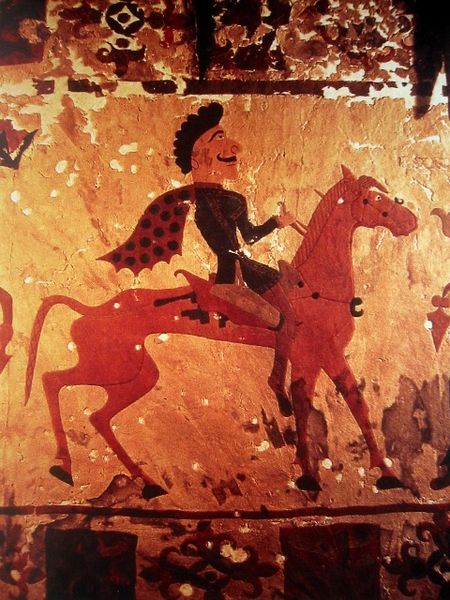 A Scythian horseman from the area invaded by the Yuezhi, Pazyryk, c.300 BCE. 월지족이 침공한 지역의 스키타이 기마인, 파지릭, 기원전300년경. The Yuezhi sometimes practiced the exchange of hostages with the Xiongnu, and at one time were hosts to Modu Shanyu (Ch:冒頓), son of the Xiongnu leader. Modu stole a horse and escaped when the Yuezhi tried to kill him in retaliation for an attack by his father. Modu subsequently became ruler of the Xiongnu after killing his father. 월지족은 때때로 흉노와 인질을 교환했으며, 흉노 추장의 아들 모돈선우는 한 때 월지족에게 인질이 되었다. 월지족이 모돈선우의 아버지에 의한 공격에 대한 보복으로 모돈선우를 죽이려 할 때 모돈선우는 말을 훔쳐 도망갔다. 모돈선우는 그의 아버지를 죽인 후에 이어서 흉노의 왕이 되었다. Around 177 BCE, led by one of Modu's tribal chiefs, the Xiongnu invaded Yuezhi territory in the Gansu region and achieved a crushing victory. Modu boasted in a letter to the Han emperor that due to "the excellence of his fighting men, and the strength of his horses, he has succeeded in wiping out the Yuezhi, slaughtering or forcing to submission every number of the tribe". The son of Modu, Jizhu, subsequently killed the king of the Yuezhi and, in accordance with nomadic traditions, "made a drinking cup out of his skull."(Shiji 123. Watson1961:231). 기원전177년경, 모돈 부족 추장 중의 한 명이 이끄는 흉노족은 감숙성의 월지 영역을 침공하여 결정적인 승리를 거두었다. 모돈은 한(漢) 황제에게 편지로 자랑하기를 “그의 병사의 뛰어남과 말의 힘으로 월지족을 소탕하는데 성공했으며, 대량으로 죽이거나 부족의 전 인원의 항복을 받아냈다”라고 했다. 모돈의 아들 지주[기주/한자이름 아직 모름]는 이어서 월지의 왕을 죽였고, 유목민 전통에 따라 그의 해골로 마시는 잔을 만들었다. Following Chinese sources, a large part of the Yuezhi people therefore fell under the domination of the Xiongnu, and these may have been the ancestors of the Tocharian speakers attested in the 6th century CE. A very small group of Yuezhi fled south to the territory of the Proto-Tibetan Qiang, and came to be known to the Chinese as the "Small Yuezhi". According to the Hanshu, they onl y numbered around 150 families. 중국사료에 의하면, 그 결과 월지족의 대부분은 흉노의 지배아래 떨어졌고, 월지족은 서기 6세기 토하르 언어 사용자의 조상일수도 있는 것이다. 월지족의 작은 부족은 티벳트인의 원부족인 강족(羌族)의 땅 남쪽으로 이주했으며, 중국에는 “소월지”로 알려졌다. 한서(漢書)에 의하면 그들은 단지 150가구에 불과했다고 한다. Finally, a large group of the Yuezhi fled from the Tarim Basin / Gansu area towards the northwest, first settling in the Ili valley, immediately north of the Tian Shan mountains, where they confronted and defeated the Sai (Sakas or Scythians): "The Yuezhi attacked the king of the Sai who moved a considerable distance to the south and the Yuezhi then occupied his lands" (Han Shu 61 4B). The Sai undetook their own migration, which was to lead them as far as Kashmir, after travelling through a "Suspended Crossing" (probably the Khunjerab Pass between present-day Xinjiang and northern Pakistan). The Sakas ultimately established an Indo-Scythian kingdom in northern India.[citation needed] 결국 대월지족은 타림분지/감숙성 지역에서 북서쪽으로 이주했으며, 처음에는 바로 천산 북쪽에 있는 이리하(伊犁河) 계곡에 정착했으며, 이곳에서 색(塞/사카족 또는 스키타이족)종을 만나 패배시켰다: “월지는 사카의 왕을 공격했으며, 사카 왕은 남쪽으로 상당히 멀리 이주했고, 그래서 월지족은 그의 땅을 차지했다(한서). 사카족은 이민을 시작했고, 그리하여 이들은 카슈미르까지 멀리 오게 되었는데, “국경선 보류지역”을 통과한 후의 일이다(아마도 Khunjerab Pass지역으로 현재 After 155 BCE, the Wusun, in alliance with the Xiongnu and out of revenge from an earlier conflict, managed to disloge the Yuezhi, forcing them to move south. The Yuezhi crossed the neighbouring urban civilization of the Dayuan in Ferghana, and settled on the northern bank of the Oxus, in the region of Transoxiana, in modern-day Tajikistan and Uzbekistan, just north of the Hellenistic Greco-Bactrian kingdom. The Greek city of Alexandria on the Oxus was apparently burnt to the ground by the Yuezhi around 145 BCE.[citation needed] 기원전155년이후, 오손(烏孫)족은 흉노와 동맹을 맺고 전번의 분쟁에 대한 보복으로 월지족을 간신히 쫓아냈으며, 그들을 남쪽으로 이주하게 했다. 월지족은 이웃하는 도시문명인 페르가나의 대완(大宛)과 접촉하였고, 아무다르여강(옥수스강)의 북안(北岸)에 정착했고, 이곳은 트란스옥시아나 지역이고, 현재의 타지크스탄과 우즈베키스탄으로, 희랍화된 희랍-박트리아 왕국(대하)의 바로 북쪽에 있다. 희랍 도시 옥수스강의 알렉산드리아 도시는 기원전145년 분명히 월지족에 의하여 불타서 잿더미가 되었다(논거가 필요). 3) Settlement in Transoxiana 트란스옥시아나에 정착 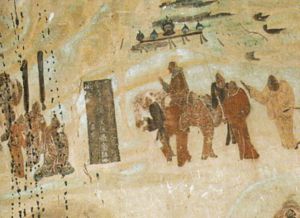 The Chinese mission of Zhang Qian to the Yuezhi in 126 BCE, Mogao Caves, 618-712 CE mural painting. 기원전126년 월지족을 향한 중국 사신 장건(張騫), 막고굴, 서기 618-712년의 벽화. [트란스옥시아나: 옥수스강(아무다르여강)을 가로지르는 지역.] The Yuezhi were visited by a Chinese mission, led by Zhang Qian in 126 BCE[17] , that was seeking an offensive alliance with the Yuezhi to counter the Xiongnu threat to the north. Although the request for an alliance was denied by the son of the slain Yuezhi king, who preferred to maintain peace in Transoxiana rather than to seek revenge, Zhang Qian made a detailed account, reported in the Shiji, that gives considerable insight into the situation in Central Asia at that time.[18] 기원전126년 중국 사신 장건(張騫)은 월지를 방문했는데, 북쪽에서 흉노의 위협을 받고 있는 월지족과 공격적인 동맹을 맺고자 한 것이었다. 비록 동맹에 대한 요청은 살해된 월지 왕의 아들에게 거부당했지만, 그(월지왕의 아들)는 보복보다는 트란스옥시아나에서 평화를 유지하고자 했기 때문으로, 장건은 자세한 설명을 했으며, 그 내용은 사기에 기록되었는데, 그것은 그 당시 중앙아시아의 상황에 대하여 깊이 알 수 있는 것이다. Zhang Qian, who spent a year with the Yuezhi and in Bactria, relates that "the Great Yuezhi live 2,000 or 3,000 li (832-1,247 kilometers) west of Dayuan (Ferghana), north of the Gui (Oxus) river. They are bordered on the south by Daxia (Bactria), on the west by Anxi (Parthia), and on the north by Kangju (beyond the middle Jaxartes). They are a nation of nomads, moving from place to place with their herds, and their customs are like those of the Xiongnu. They have some 100,000 or 200,000 archer warriors."[19] 박트리아에서 월지족과 1년을 보낸 장건은 다음과 같이 설명했다. “대월지는 규수(옥수스강/아무다르여강)의 북쪽에 있는 대완(大宛/페르가나)에서 서쪽으로 2천리 또는 3천리(832-1247km) 떨어진 곳에 살고 있다. 대월지는 남쪽으로 대하(박트리아), 서쪽으로는 안식국(파르티아), 북쪽으로는 강거(康居/시르다르여 강 중류 넘어서 있음)와 국경을 이루고 있다. 이들은 유목민 국가로, 가축과 함께 장소를 옮겨 살고, 풍습은 흉노와 같다. 궁수(弓手) 병사는 약 10만 또는 20만명이다.” [이 문단의 내용을 살펴보면, 대월지는 카자흐스탄의 시르다르여강 하류에 있는 “키질 오르다”가 중심지처럼 보인다. 마침 이곳은 거란족의 영주 지역으로 추정되고 있는데, 거란은 키탄으로 월지와 같은 스키타이족이다.] Although they remained north of the Oxus for a while, they apparently obtained the submission of the Greco-Bactrian kingdom to the south of the 그들은 비록 옥수스의 북쪽에 잠시 머물렀지만, 그들은 분명히 옥수스의 남쪽에 있는 희랍-박트리아 왕국을 복종시켰다. 월지는 5개의 주요 부족으로 조직되었는데, 각각은 야브구(제후) 또는 부족장에 의해 통치되었고, 그 부족은 중국에 다음과 같이 알려졌다: 서부 와한(Wakhān)과 지박(Zibak)에 있는 휴밀(休密), 바다흐샨(Badakhshan)과 그 옆에 있는 옥수스 북쪽 영역에 있는 귀상(貴霜), 슈그흐난(Shughnan) 지역의 쌍미(雙靡), 발크(Balk) 지역의 힐돈(肸頓), 테르메즈(Termez) 지역의 도밀(都密) 등이다. A description of the Greco-Bactrian kingdom was made by Zhang Qian after the conquest by Yuezhi: "Daxia (Greco-Bactria) is located over 2,000 li southwest of Dayuan, south of the Gui (Oxus) river. Its people cultivate the land and have cities and houses. Their customs are like those of Ta-Yuan. It has no great ruler but onl y a number of petty chiefs ruling the various cities. The people are poor in the use of arms and afraid of battle, but they are clever at commerce. After the Great Yuezhi moved west and attacked the lands, the entire country came under their sway. The population of the country is large, numbering some 1,000,000 or more persons. The capital is called the city of 월지에 의해 정복된 희랍-박트리아 왕국에 대하여 장건은 다음과 같이 서술했다: “대하(희랍-박트리아)는 대완의 남서쪽으로 2천리 넘어서, 규수(아무다르여강)의 남쪽에 있다. 사람들은 땅을 경작하고 도시와 집이 있다. 풍습은 대완과 같다. 대군장(大君長)은 없지만 여러 도시를 다스리는 소장(小長)이 있다. 사람들은 무기를 다루는데 서투르고 전쟁을 두려워하며, 그러나 상업에는 영리하다. 대월지가 서쪽으로 이주하여 그 영토를 침공한 후에, 그 나라 전 영토는 대월지의 통치가 되었다. 그 나라 인구는 많은데 약100만명 이상이다. 수도는 란스(박트라/현재 발크흐)이고 시장에서 여러 상품이 매매된다.” In a sweeping analysis of the physical types and cultures of Central Asia that he visited in 126 BCE, Zhang Qian reports that "although the states from Dayuan west to Anxi (Parthia), speak rather different languages, their customs are generally similar and their languages mutually intelligible. The men have deep-set eyes and profuse beards and whiskers. They are skilful at commerce and will haggle over a fraction of a cent. Women are held in great respect, and the men make decisions on the advice of their women."[22] 기원전26년 그가 방문했던 중앙아의 물산과 문화에 대한 포괄적이 분석에서, 장건은 보고하기를 “비록 대완에서 서쪽으로 안식국(파르티아)까지의 나라들은 좀 다양한 언어를 사용하고 있지만, 그들의 풍습은 일반적으로 단순하고 그들의 언어는 서로 알기가 쉽다. 남자는 깊은 눈과 풍부한 턱수염과 구레나룻을 가지고 있다. 그들은 장사에 밝고 푼돈을 가지고도 다툰다. 여성들은 크게 존경을 받고 있으며, 남성은 여성의 충고에 따라 결정을 한다.” 4) Invasion of 박트리아의 침공 One of the first Yuezhi coins, imitative, in crude style, of the coins of the Greco-Bactrian king Heliocles, circa 120 BCE. 첫번째 월지 주화 중의 하나, 희랍-박트리아 왕 헬리오클레스의 주화를 조잡하게 모방한 것임, 기원전120년경. 좌측: 희랍왕실 머리띠를 두르고 있는 월지 추장으로 추정되는 흉상. 우측: 벼락과 권장(權杖/왕권)의 제우스 신. 헬리오클레스 왕에 대한 철자가 잘못된 희랍어 명문(銘文) BASILEO HELIOLEEU. 서기 1년 아시아, 토하르족/월지족의 위치를 보여주고 있음. [마우스 클릭하면 확대사진 링크] In 124 BCE the Yuezhi were apparently involved in a war against the Parthians, in which the Parthian king Artabanus I of Parthia was wounded and died: "During the war against the Tokharians, he (Artabanus) was wounded in the arm and died immediately" (Justin, Epitomes, XLII,2,2: "Bello Tochariis inlato, in bracchio vulneratus statim decedit"). 기원전124년 월지족은 분명히 파르티아 제국과 전쟁에 돌입했고, 여기서 파르티아 왕 아르타바누스1세는 부상을 입고 죽었다: “토하르족과 전쟁 중에, 그(아르타바누스)는 팔에 부상을 입었으며 즉시 죽었다.”(Justin) Some time after 124 BCE, possibly disturbed by further incursions of rivals from the north, and apparently vanquished by the Parthian king Mithridates II, successor to Artabanus, the Yuezhi moved south to Bactria. Bactria had been conquered by the Macedonians under Alexander the Great in 330 BCE, and since settled by the Hellenistic civilization of the Seleucids and the Greco-Bactrians for two centuries. 기원전124년 후의 얼마 후에, 아마도 북쪽으로부터 경쟁자의 깊은 침입으로 교란당하고, 아르타바누스의 승계자 파르티아왕 미트리다테스2세에 의해 격파 당한 월지족은 남쪽으로 박트리아로 이주했다. 박트리아는 기원전330년 알렉산더 대왕의 마케도니아 왕국에 정복되었었으며, 그 때부터 2세기 동안 셀레우코스 왕조와 희랍-박트리아 왕조의 헬레니즘 문명이 정착되었다. This event is recorded in Classical Greek sources, when Strabo presented them as a Scythian tribe, and explained that the Tokharians -- together with the Assianis, Passianis and Sakaraulis -- took part in the destruction of the Greco-Bactrian kingdom in the second half of the 2nd century BCE: "Most of the Scythians, beginning from the Caspian Sea, are called Dahae Scythae, and those situated more towards the east Massagetae and Sacae; the rest have the common appellation of Scythians, but each separate tribe has its peculiar name. All, or the greatest part of them, are nomads. The best known tribes are those who deprived the Greeks of Bactriana, the Asii, Pasiani, Tochari, and Sacarauli, who came from the country on the other side of the Jaxartes, opposite the Sacae and Sogdiani." (Strabo, 11-8-1) 이 사건은 고대 희랍 사료에 기록되었는데, 그 당시에 스트라보는 그들을 스키타이족으로 소개했으며, 설명하기를 토하르족은 아시아니스족[아시족], 파시아니스족 그리고 사카라울리스족[사카족] 등과 함께 기원전2세기 후반에 희랍-박트리아 왕국을 파괴하는데 참여했다: “카스피해에서 출발한 대부분의 스키타이족은, 다해 스키태로 불리고, 더 동쪽에 있는 것은 마사케태와 사캐라고 한다{불완전문장}; 그 나머지는 스키타이라는 일반 명칭을 가지고 있으며, 그러나 각각 분리된 부족은 그의 독특한 이름을 가지고 있다. 그들 대부분은 유목민이다. 가장 잘 알려진 부족들은 희랍으로부터 박트리아를 빼앗은 아시족, 파시아니족, 토하르족 그리고 사카라울리족으로, 이들은 시르다르여강(작사르테스)의 반대편 국가에서 즉 사캐와 소그드의 반대편 온 것이다.” (스트라보) {해설: 드디어 모순점이 나왔습니다. The last Greco-Bactrian king Heliocles I retreated and moved his capital to the As they settled in 희랍-박트리아의 마지막 왕 헬리오클레스1세는 후퇴하여 수도를 카불 계곡으로 옮겼다. 박트리아의 동부는 파슈툰 족에게 점령되었다. 그들이 기원전125년경부터 박트리아에 정착하자, 월지족은 어느 정도 헬레니즘화 되었는데, 그 이유는 희랍 문자를 채택한 점과 희랍문자와 더불어 희랍-박트리아 왕들의 스타일로 주조된 잔존하는 일부 주화에 의해서 암시되고 있기 때문이다. 그들이 정착한 박트리아 지역은 토하리스탄(토하르왕국)으로 알려졌는데, 그 이유는 월지족은 희랍인들에게 “토하르족”으로 불렸기 때문이다. Commercial relations with 중국과의 상업 거래 또한 활발하였는데, 그 이유는 많은 중국인 사절이 기원전1세기 내내 보내졌기 때문이다: “외국으로 이러한 사절의 최대 규모는 700명이고, 반면에 심지어 가장 적은 숫자도 100명을 넘는다…. 1년 동안 어느 곳에서든지 5개 6개에서 10개의 사절단이 보내지곤 하였다.”(사기, 번역 버튼 왓슨) The Hou Hanshu also records the visit of Yuezhi envoys to the Chinese capital in 2 BCE, who gave oral teachings on Buddhist sutras to a student, suggesting that some Yuezhi already followed the Buddhist faith during the 1st century BCE (Baldev Kumar (1973)). 후한서에 또한 기록하기를 월지의 사절이 기원전2년에 중국 수도를 방문했으며, 그는 불경을 제자에게 구두로 강의하였고, 일부 월지족은 기원전1세기 동안 불교를 믿고 있다고 제시하였다(Baldev Kumar (1973)). A later Chinese annotation in Shiji made by Zhang Shoujie during the early 8th century quoted Wan Zhen's Strange Things from the Southern Region (a now-lost text of from the Wu kingdom) describes the Kushans as living in the same general area north of India, in cities of Greco-Roman style, and with sophisticated handicraft. The quote are dubious, as Wan Zhen probably never visited the Yuezhi kingdom through the Silk Road, though he might had gathered his information from the trading ports in the coastal south.[15] The Chinese never adopted the term "Guishuang", and continued to call them "Yuezhi": 서기 8세기 초에 장셔우지에의 사기 주석에서 ‘완전’의 ‘남부 지역의 기이(奇異)’(동오(東吳)의 잃어버린 문서)에 대한 인용이 있으며, 즉 쿠샨왕조는 인도의 북쪽 지역에서, 희랍-로마 양식의 도시에서, 정교한 수제품과 더불어 살고 있다고 서술하고 있다. 그 인용은 매우 의심스러운데 왜냐면 남부 해안 무역항에서 정보를 수집하였을지 언정, 완전은 아마도 결코 월지왕국을 실크로드를 통해 방문한 적이 없기 때문이다. 중국은 결코 ‘귀상’이라는 용어를 채택하지 않았고, 계속해서 “월지”라고 불렀다. "The Great Yuezhi [Kushans] is located about seven thousand li (about 3000 km) north of “대월지(쿠샨)는 인도의 북쪽으로 약 7천리(약3천km)에 있다. 그 땅은 높은 데 있다; 기후는 건조하다; 그 지역은 궁벽한 곳에 있다. 그 나라의 왕은 자신을 “천자”라고 부른다. 그 나라에는 매우 많은 승마용 말이 있어서 그 숫자가 종종 70만 마리에 이른다. 도시 배치와 궁전들은 대진(大秦/로마)의 것과 매우 비슷하다. 그곳 사람들의 피부는 불그스름하고 하얗다. 사람들은 기마 궁술에 뛰어나다. 지방 생산품, 희귀한 것, 보물, 의복, 그리고 가구류는 매우 양호하고, 심지어 인도와는 비교할 수 없다(인도보다 뛰어남).” 5) Expansion into the Hindu-Kush 힌두쿠쉬로의 확장 A posthumus, slightly barbarized, coin of Hermaeus, minted in the Paropamisadae between 50 BCE and 25 BCE. 헤르마에우스 왕(기원전90-70년)의 사후의 주화로 좀 조잡하고, 기원전 50-20년 사이에 파로파미사대에서 주조되었다.(힌두쿠시 지역) 좌측:헤르마에우스 흉상. 희랍어 명문 BASILEOS SOTIROS ERMAIOU은 “구세 왕 헤르마에우스”. [SOTIROS는 soter로 구세주이고, 희랍어 H는 우측: 제우스, 후광이 없고, 자비를 베푸는 모습. 하로슈티 문자 명문: MAHARAJASA TRATARASA HERAYAMASA. [원문에 대한 영문 번역이 잘못 되어 있다. 마하:대(大), 라자사: 왕, 트라타라사: 3?이라는 뜻이고, 헤라야마사는 제우스의 별명인 것 같다. The area of the Hindu-Kush (Paropamisadae) was ruled by the western Indo-Greek king until the reign of Hermaeus (reigned c. 90 BCE–70 BCE). After that date, no Indo-Greek kings are known in the area, which was probably overtaken by the neighbouring Yuezhi, who had been in relation with the Greeks for a long time. According to Bopearachchi, no trace of Indo-Scythians occupation (nor coins of major Indo-Scythian rulers such as Maues or Azes I) have been found in the Paropamisadae and western Gandhara. 힌두쿠쉬(파로파미사대) 지역은 서양인 인도-희랍왕에 의해 통치되었는데 마지막은 헤르마에우스 왕(재위 기원전90-70년)이다. 그 이후로 어떠한 인도-희랍왕도 그 지역에서 알려져 있지 않는데, 아마도 이웃 월지족이 점령했기 때문일 것이고, 월지는 예전부터 오랫동안 희랍인과 관련을 맺고 있었다. 보페라치치에 의하면 인도-스키타이인이 점거한 어떠한 흔적도 파로파미사대(힌두쿠시)와 서부 간다라에서 발견되지 않는다고 한다(즉 마우에스 또는 아제스1세와 같은 인도-스키타이인 통치자의 어떠한 주화도 없다). As they had done in Bactria with their copying of Greco-Bactrian coinage, the Yuezhi copied the coinage of Hermeaus on a vast scale, up to around 40 CE, when the design blends into the coinage of the Kushan king Kujula Kadphises. 그들은 박트리아에서 희랍-박트리아 주화를 모방하고 있었기 때문에, 월지족은 헤르마에우스의 주화를 대량으로 모방했는데, 약 서기 40년까지이고, 그때 그 디자인은 쿠샨왕 쿠줄라 카드피세스(구취각)의 주화와 섞였다. The first presumed, and documented, Yuezhi prince is Sapadbizes (probably a yabgu's prince of Yuezhi confederation), who ruled around 20 BCE, and minted in Greek and in the same style as the western Indo-Greek kings. 처음이라 여겨지고 기록된 월지 왕자는 사파드비제스(아마도 월지 연맹의 야브구(제후)의 왕자)이고, 기원전20년경 통치했으며, 희랍어로 그리고 서부 인도-희랍 왕들과 같은 형태로 주조했다. 6) Foundation of the Kushan empire 쿠샨 제국의 건설 By the end of the 1st century BCE, one of the five tribes of the Yuezhi, the Guishuang (Ch: 貴霜, origin of name Kushan adopted in the West), managed to take control of the Yuezhi confederation. According to some theories[citation needed], the Guishuang may have been distinct from the Yuezhi, possibly of Saka origins. From that point, the Yuezhi extended their control over the northwestern area of the Indian subcontinent, founding the Kushan Empire, which was to rule the region for several centuries. The Yuezhi came to be known as Kushan among Western civilizations, however the Chinese kept calling them Yuezhi throughout their historical records over a period of several centuries. 기원전1세기 말에, 월지족의 5부족 중의 하나인 귀상족(貴霜族, 서양에서 채택된 쿠샨의 어원)은 월지 연맹의 통치권을 간신히 얻었다. 일부 이론들(논거필요)에 의하면, 귀상족은 아마도 사카 출신 월지족과 구별될 수도 있다. 그 시점에서부터(?), 월지족은 인도 대륙의 북서부 지역에 대한 통치를 확장했으며, 쿠샨제국을 건설하고 수세기 동안 그 지역을 통치하게 되었다. 월지는 서구 문명에는 쿠샨으로 알려졌지만, 그러나 중국은 수세기 동안 역사적 기록을 통틀어 그들을 계속 월지라고 불렀다. The Yuezhi/ Kushans expanded to the east during the 1st century CE, to found the Kushan Empire. The first Kushan emperor Kujula Kadphises ostensibly associated himself with Hermaeus on his coins, suggesting that he may have been one of his descendants by alliance, or at least wanted to claim his legacy. 월지/쿠샨은 서기1세기 동안 동쪽으로 확장하여 쿠샨제국을 건설했다. 첫 번 째 쿠샨 황제 쿠줄라 카드피세스는 표면상 주화에다 자신을 헤르마에우스와 관련시켰는데, 그는 연맹에 의해 그(헤르마에우스)의 자손들 중의 한 명일 수도 있거나, 적어도 그의 유산을 갖기를 요구했다는 것을 암시한다. Obv: Bust of Heraios, with Greek royal headband. Rev: Horse-mounted King, crowned with a wreath by the Greek goddess of victory Nike. Greek legend: TVPANNOVOTOΣ HΛOV - ΣΛNΛB - KOÞÞANOY "The Tyrant Heraios, Sanav (meaning unknown), of the Kushans". 첫 번 째 자칭 쿠샨 왕 헤라이오스(서기1-30년), 희랍-박트리아 양식. 좌측(앞면): 헤라이오스 흉상, 희랍 왕실 머리 띠를 두르고 있음. 우측(뒷면): 말을 탄 왕, 희랍 승리의 여신 니케에 의해 화환으로 왕관을 쓰고 있다. 희랍어 명문: TVPANNOVOTOΣ HΛOV - ΣΛNΛB – KOÞÞANOY은 “쿠샨의 절대 군주 헤라이오스, 사나브(의미 모름)”. Depiction of Heraios, from his clearest coins. 그의 가장 선명한 주화에서 헤라이오스 묘사. Possible Yuezhi king and attendants. Gandhara stone palette, 1st century CE. 아마도 월지왕과 시종들. 간다르 원반석, 서기 1세기. The unification of the Yuezhi tribes and the rise of the Kushan is documented in the Chinese Historical chronicle Hou Hanshu: "More than a hundred years later, the xihou (Ch:翖侯, "Allied Prince") of Guishuang (Badakhshan and the adjoining territories north of the Oxus), named Qiujiu Que (Ch: 丘就卻, Kujula Kadphises) attacked and exterminated the four other xihou ("Allied Princes"). He set himself up as king of a kingdom called Guishuang (Kushan). He invaded Anxi (Parthia) and took the Gaofu (Ch:高附, Kabul) region. He also defeated the whole of the kingdoms of Puda and Jibin (Ch: 罽賓, Kapiśa-Gandhāra). Qiujiu Que (Kujula Kadphises) was more than eighty years old when he died. His son, Yan Gaozhen (Ch:閻高珍) (Vima Takto), became king in his place. He returned and defeated Tianzhu ( 월지 부족들의 통합과 쿠샨의 등장은 중국 사서 후한서에 다음과 같이 기록되어 있다: “100여년 후에, 귀상(바다흐샨과 아무강 북쪽의 근접 영역)의 흡후(翖侯/연맹 왕자) 구취각(丘就卻, Kujula Kadphises)은 다른 네 흡후를 공격하여 전멸시켰다. 그는 자신을 귀상 왕국의 왕이라 자칭했다. 그는 또한 푸다와 계빈(罽賓, Kapiśa-Gandhāra)의 모든 왕국들을 패배시켰다. 구취각은 80세 이상이 되어 사망했다. 그의 아들 염고진(閻高珍, Vima Takto, 웨마)은 이어서 왕이 되었다. 그는 되돌아 와서 천축국(인도북서쪽)을 패퇴시키고 그곳에 장군을 봉하여 감독하고 다스리게 했다. 월지는 그때 지극히 번영하였다. 모든 왕국들은 귀상왕이라고 불렀지만, 한나라는 원래 이름 대월지라고 불렀다.”(후한서) The Yuezhi/Kushan integrated Buddhism into a pantheon of many deities, became great promoters of Mahayana Buddhism, and their interactions with Greek civilization helped the Gandharan culture and Greco-Buddhism flourish. 월시/쿠샨은 불교를 다신교와 통합하였으며, 대승불교의 큰 장려자가 되었으며, 희랍문명과 상호 교류에 의해 간다라 문화와 희랍-불교가 번영하게 되었다. During the 1st and 2nd century, the Kushan Empire expanded militarily to the north and occupied parts of the Tarim Basin, their original grounds, putting them at the center of the lucrative Central Asian commerce with the Roman Empire. When the Han Dynasty desired to advance north, Emperor Wu sent the explorer Zhang Qian to see the kingdoms to the west and to ally with the Yuezhi people, in order to fight the Xiongnu Mongol tribe. The Yuezhi continued to collaborate militarily with the Chinese against nomadic incursion, particularly with the Chinese general Ban Chao against the Sogdians in 84 CE, when the latter were trying to support a revolt by the king of Kashgar. Around 85 CE[citation needed], they also assisted the Chinese general in an attack on Turfan, east of the 서기 1세기 2세기 동안에, 쿠샨제국은 군대를 북쪽으로 진격하여 그들의 원 고향인 타림 분지의 일부를 점령했으며, 그곳을 로마제국과 중앙아시아 교역에 유리한 중심지로 만들었다. 한(漢) 왕조가 북쪽으로 진격하기를 원했을 때에, 한무제는 탐험가 장건(張騫)을 보내 서부의 왕국들을 보고 월지족과 연맹하게 하였는데, 흉노 몽고족과 싸우기 위함이었다. 월지족은 계속해서 유목민의 침입에 대항하여 중국과 군사적으로 협력하였으며, 특히 서기 84년 소그드에 대항하여 중국 장군 반초(班超)와 협력했으며, 그 때 후자(소그드/반초?)는 카쉬가르 왕의 반란을 지지하고자 하였다. 85년경(논거부족)에, 그들은 또한 타림 분지 동쪽의 투르판을 공격하는데 있어서 중국 장군을 도왔다. {이 단락은 기존의 것과 다른 점이 많습니다.} In recognition for their support to the Chinese, the Kushans requested, but were denied, a Han princess, even after they had sent presents to the Chinese court. In retaliation, they marched on Ban Chao in 86 CE with a force of 70,000, but, exhausted by the expedition, were finally defeated by the smaller Chinese force. The Kushans retreated and paid tribute to the Chinese Empire during the reign of the Chinese emperor Han He (89-106). 중국에 대한 그들[쿠샨]의 지지에 대한 보답으로, 쿠샨은 한나라 공주를 요청했지만, 거절되었으며, 심지어 그들(쿠샨)이 선물을 중국 왕실에 보낸 후에도 그러했다. 보복으로 쿠샨은 7만의 병사로 서기86년 반초를 공격했으나, 원정으로 체력이 소진되어, 결국 더 작은 중국 군에게 패배 당했다. 쿠샨은 후퇴하여 한화제(漢和帝/89-106년) 통치기간 동안 중국황제에게 조공을 바쳤다. Later, the Yuezhi/Kushans established a kingdom centered on Kashgar around 120 CE[citation needed], and introduced the Brahmi script, the Indian Prakrit language for administration, and Greco-Buddhist art which developed into Serindian art. 나중에, 월지/쿠샨은 서기120년경 카슈가르에 자리잡은 왕국을 건설했으며(논거요청됨), 브라미 문자와 행정 언어로 인도 프라크리트 언어 그리고 세린디안 예술로 발전한 희랍-불교 예술을 도입했다. Benefiting from this territorial expansion, the Yuezhi/Kushans were among the first to introduce Buddhism to northern and northeastern 영토 확장으로 이득을 얻은 월지/쿠샨은 불교를 아시아 북부와 북동부에 소개하는 첫 번 째 중에 속하였는데, 즉 직접적인 사절(선교사)의 노력과 불전을 중국어로 번역하는 것을 통해서이다. 주요한 월지 포교사 이면서 번역가로는 로칵세마(지루가참(支婁迦讖))와 다르마락샤(Dharmarakṣa /축법호(竺法護))이고, 이들은 중국에 가서 번역 관청을 세웠으며, 그 때문에 실크로드에서 불교 전도의 중심이 된 것이다. The Chinese kept referring to the Kushans as Da Yuezhi throughout the centuries. In the Sanguozhi (三國志, chap 3), it is recorded that in 229 CE "The king of the Da Yuezhi, Bodiao 波調 (Vasudeva I), sent his envoy to present tribute, and His Majesty (Emperor Cao Rui) granted him the title of "King of the Da Yuezhi Intimate with the Wei (魏)." [지루가참(支婁迦讖): 서기 147년 탄생. Lokakṣema 는 산스크리트어로 ‘세계의 복지’라는 뜻. 그는 대승불교 경전을 중국어로 번역한 초기의 불교 승려이다. 그는 간다라 월지족의 쿠샨인이다. 성씨 지(支)는 월지에서 따온 것이다. 그의 모국어는 토하르어이다. 대승불교 번역서: Prajñāpāramitā Sūtra/ 도행반야경(道行般若經), Pratyutpanna Sutra/ 반주삼매경(般舟三昧經), 아도세왕경(阿闍世王經), 잡비유경(雜譬喩經), 수릉엄경(首楞嚴經), 무량청정평등각경(無量淸淨平等覺經), 보적경(寶積經) 등. 해설: 위 경중에서 수릉엄경과 보적경은 성명쌍수 수련과 관련이 깊은 경전입니다. 다르마락샤(Dharmarakṣa /축법호(竺法護): 대승불교 번역가. 가족은 돈황에 살았고, 그곳에서 서기230년에 탄생했다. 젊었을 때 서역 여러나라를 여행하고 중앙아시아의 언어와 문자를 배웠다. 묘법련화경(妙法蓮華經)을 번역했다. 약 154개의 상좌부 불경과 대승 불경을 번역했다. 번역서: Saddharmapunnarnkasūtr/ 정법화경(正法華經), Pancavimsatisāhasrikāprajnāpāramistasūtra /광찬반야바라밀경(光贊般若波羅密經), Danabhūmikasūtra / 점비일절지덕경(漸備一切智德經), Lalitavistara/ 보요경(普曜经) 등. ] |
